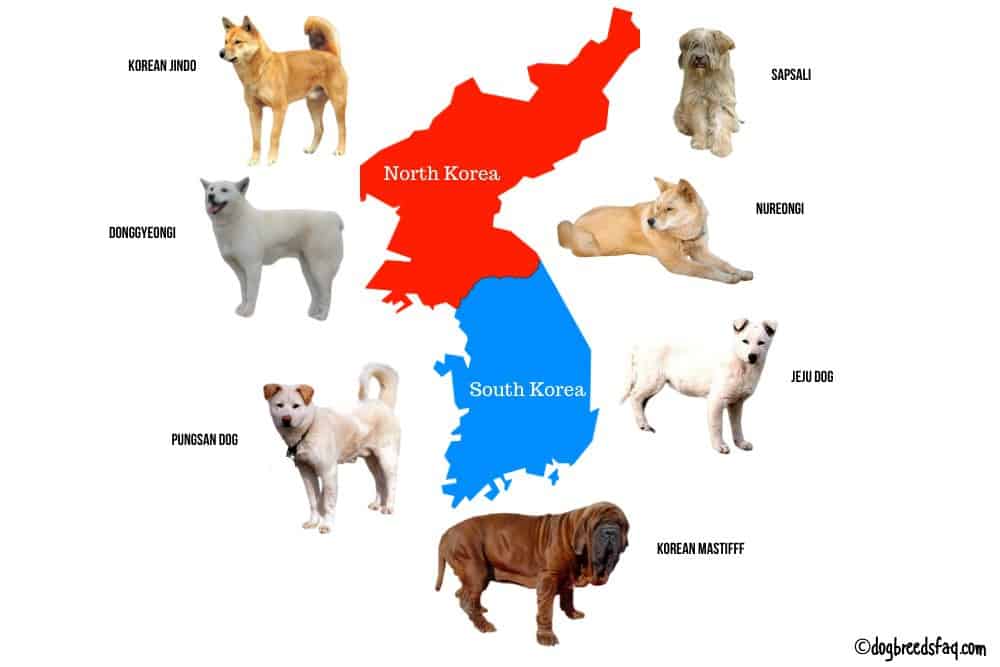When most people think of Korea, they think of a nation that doesn’t necessarily welcome dogs but consumes them.
And while the unfathomable tradition of consuming dog meat was once very prevalent in Korean society, it seems the trend is dwindling.
So without further ado, let’s look at the top 7 popular Korean dog breeds to see which dogs they welcome the most.
Start Watching or Continue Reading==>
1. KOREAN MASTIFF (Dosa Gae)
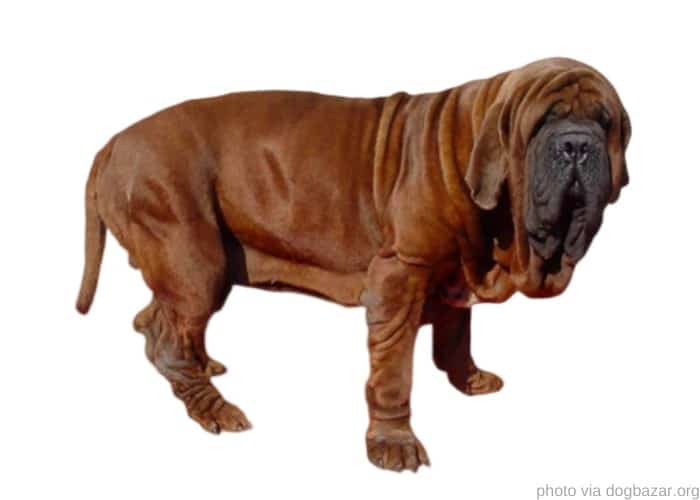 Description:
Description:
The Korean Mastiff is best known for its wrinkly face, body, and massive size.
This breed’s skin under the chin and around the neck resembles a Bully Kutta dog from Pakistan.
This Korean dog breed weighs between 65-85 kg (145-185 pounds) and stands over 23-30 inches tall.
The breed can range in color, from golden to light brown to chocolate and dark brown to black.
Some Korean Mastiffs can even have tinges of mahogany and red in their coats.
Aside from color, the coat of a Korean Mastiff is described as short, silky, and shiny.
The Korean Mastiff has a rectangular-shaped body with a massive head, broad nose, and droopy ears.
Personality and Temperament:
With the massive size and wrinkly appearance of the Korean Mastiff, it’s no surprise that they made the top 7 Korean dog breeds list.
With that being said, many people find their appearance beautiful and majestic. Others find their size intimidating.
However, the Korean Mastiff is a very sweet-natured, loving breed that makes an excellent family pet despite its rough and tough exterior.
Their owners often refer to them as “gentle giants” who, despite their size, would like to think they are lap dogs.
The breed is known to form strong bonds with people and is considered patient, nurturing, and protective (but not aggressive).
The breed has low energy levels and is not considered overly active. Due to their low exercise requirements, they are often regarded as great apartment dogs.
History:
The history of the Korean Dosa Mastiff can be traced back to the early 1800s, but historians and researchers don’t know much about how the breed came to be.
With that being said, there is some speculation that these popular dog breeds in Korea came about through cross-breeding with working dogs like the English Bulldog, the English Mastiff, the Tosa Inu, the Dogue de Bordeaux, and even the bloodhound.
Through selective breeding, the Mastiff came to be what it is today.
Did You Know?
- The Korean Mastiffs are primarily bred as show dogs and pets
- The Korean Mastiff was one of the most expensive dogs ever exported to India for over USD 140,000. They remain the most expensive dog breed in India
- The life expectancy of a Korean Mastiff is between 7-12 years
- A full-grown Mastiff can eat between 11-12 cups of food twice daily!
2) Korean Jindo
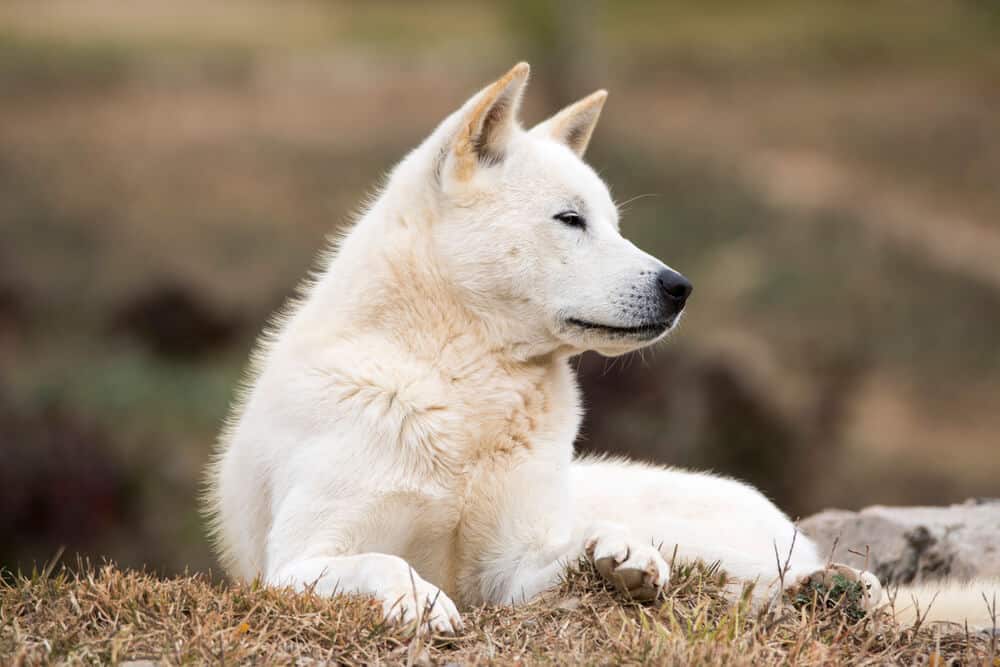
Description:
The Korean Jindo is a mid-sized dog that stands between 18-22 inches in height and weighs anywhere between 30-50 pounds.
Its body is well proportioned and is built for hunting and guarding.
Their body is strong and agile, and their ears stand erect to always be alert.
In terms of color, the Jindo is recognized in seven different colors by the UKC. These include white, brindle, fawn, red, black, grey, and black/tan.
Personality and Temperament:
The Jindo is known for its loyalty. Though it takes time to earn a Jindo’s respect, their loyalty will be unwavering once you have it.
Because it can take a while to earn the respect of a Jindo, the early stages of training can be difficult and require a great deal of patience.
This is mainly because Jindo’s are extremely intelligent and won’t give their unwavering loyalty to just anyone.
Once it is earned, the Jindo becomes eager to please their owner.
This will motivate them to conquer even the most difficult tricks after a short training session.
In regards to training, early socialization is essential for Jindo. Though the breed is considered very gentle and loving, they can also be protective and wary of strangers.
Aggression can present itself if not socialized at a young age, and early socialization will eliminate any concern about this.
History:
The Jindo originated in South Korea, but because there are no written accounts about the breed, very little is known about their distant past.
Evidence suggests that Jindo’s existed in the Jindo province as far back as 1500 years ago.
In 1962 the breed was listed as a National Treasure, making it Korea’s national dog and almost impossible to export outside of South Korea.
This is why you will not see many “Jindo dog for sale” ads in the United States.
That said, the breed did make its way over to the US in 1980 and officially became recognized by the UKC in 1998.
Because of their agility and strong hunting abilities, many militaries, police teams, and search and rescue operations added Jindo to their team.
Despite their hunting skills and trainability, such teams quickly realized that due to the loyalty of the Jindo to one owner, they weren’t quite fit for the job.
And though it is now widely recognized that Jindo’s don’t make great military or police dogs, they are still highly respected throughout Korean culture and are currently in the top 7 types of dogs in Korea.
Did You Know?
- The Jindo has a long life expectancy compared to many other North Korean dog breeds, with an average expectancy between 12-15 years.
- The Jindo is a pack dog and thus requires a strong owner to take on the role of pack leader.
- Jindos are escape artists! They have a strong desire to roam and explore and can easily escape a 6-foot fence if desired.
- Jindos have a high prey drive and can kill large prey like boars and deer!
3) Sapsali
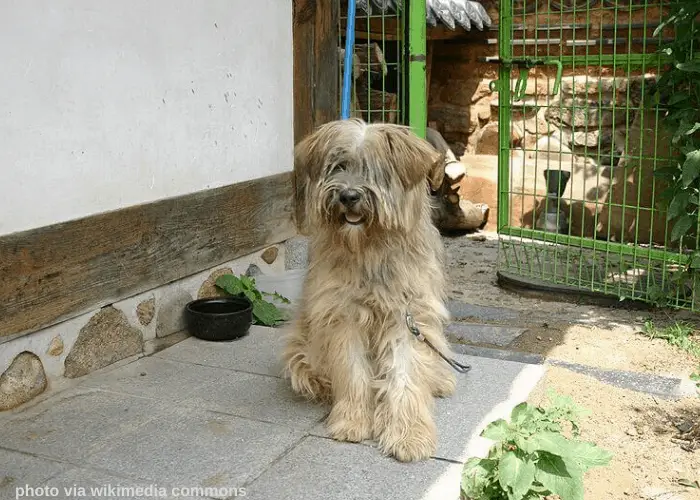 Description:
Description:
Regarding Korean dog breeds, the Sapsali is most commonly associated with the Jindo, but many people also compare it to the Old English Sheepdog.
Standing at a height of between 19-23 inches and weighing between 35-60 pounds, the Sapsali is considered a mid-sized dog breed.
The breed has a long shaggy coat with hair covering the eyes.
This cute breed often uses the nickname “lion dog,” which it earned with its large paws and broad, powerful skull.
Personality and Temperament:
Though the Sapsali can be a little wary around strangers, it is generally considered a very friendly breed.
The breed is extremely devoted and loyal to its family members, and once they see that the family is comfortable around outsiders, it will welcome them too.
The breed is exceptionally patient, making them the perfect companion for small children.
Because they are so loyal to their family, they can become highly protective of them.
Socialization is required early to ensure that this protective nature does not branch into aggression.
That said, when socialized properly, the Sapsali has an excellent temperament.
Their temperament is so calm and affectionate that they are often used as therapy dogs.
They are also very intelligent and eager to learn from their owners.
These dogs enjoy outdoor play but do not require much exercise. In return, they make excellent apartment dogs.
History:
While the origins of the Sapsali breed are unknown, there is some evidence to suggest that the breed was around in Korea as early as 37BC.
During the “Three Kingdom Period,” this breed was honored by royal families in Korea and was seen as a sign of good fortune.
Later on, the popularity of the Sapsali spread from Royal families to upper-class families, quickly becoming one of the most popular dog breeds in Korea.
Like the Jindo, the Sapsali is now defined as a National Treasure of Korea but has yet to become popular in other regions.
Did You Know?
- In ancient times, Koreans referred to the Sapsali as the “one that roots out evil spirits,” claiming the nickname “ghost dog.“
- Ghosts are believed to be afraid of the Sapsali.
- The Sapsali almost went extinct after the Korean War but was revived by a group of professors from Kyungpook National University in the 1960s.
- Sapsali is often used in Korean hospitals as a therapy dog.
4) Nureongi Dog
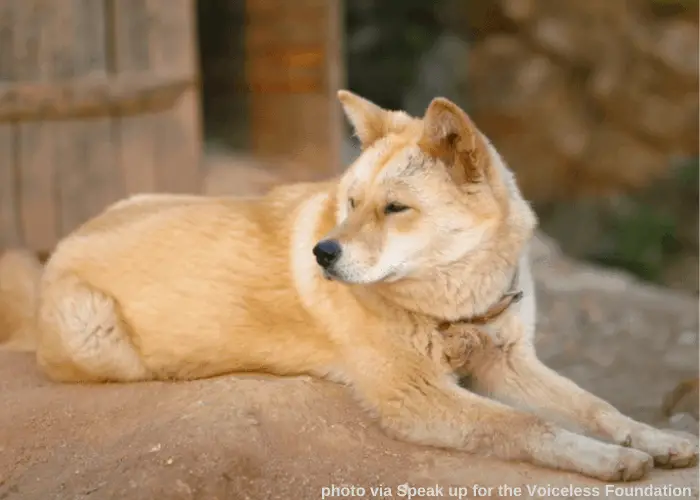 Description:
Description:
Sometimes referred to as the Korean Yellow Spitz, the Nureongi is a medium-sized dog breed that often gets compared with the Jindo.
While the two have a very similar stance and appearance, the Nureongi will usually display patches of yellow on its coat.
Unlike the Jindo, the Nureongi also has a melanistic mask or a distinct pattern on its coat.
The Nureongi has a sturdy and robust build but has short, unmuscular legs. Like the Jindo, the Nureongi has ears that point up and are always alert.
Personality and Temperament:
Earlier in the write-up, it was mentioned that Koreans have a long-standing tradition of consuming dog meat, known as “Gaegogi.”
Unfortunately, Nureongi is one of the most popular dog meats of choice. Therefore, gathering a lot of information on how they interact in a family environment is difficult.
That said, the little information suggests that Nureongi’s are an extremely gentle, non-aggressive breed of dog.
Though they have been described as extremely vocal, this vocality is believed to come from the desire to communicate with humans and other dogs around them.
History:
The Nureongi dog has long been considered some of Korea’s best “Gaegogi.”
Though they make the top 7 Korean dog breeds list, it’s not for reasons to be proud of.
Sometimes referred to as the “Tonggae” or “shit dog” by Koreans, this breed is considered livestock and is most commonly bred for its meat.
It would be rare to see a Nureongi in a family home around Korea.
With that being said, animal activists are continuously fighting for the rights of dogs and actively fighting against the sale of dogs on the black market as well.
Did You Know?
- Of all dogs on the Korean dog breeds list, the Nureongi may be the oldest. Official recordings suggest that the Nureongi has been around since the 1st Century AD, which is longer than any other dogs on the top 7 list.
5. Donggyeongi Dog
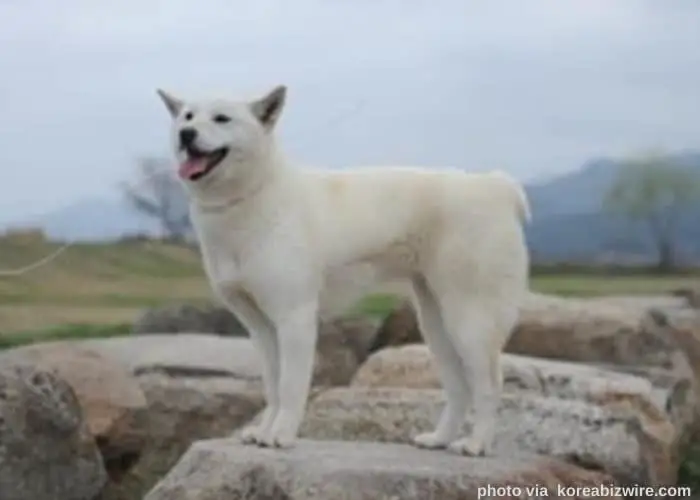 Description:
Description:
Despite being on the list of popular dog breeds in Korea, the Donggyeongi is rare.
It’s most commonly known for its bobtail, either very short or non-existent.
They are mid-sized dogs and, aside from their tails, bear a striking resemblance to the Jindo breed.
Personality and Temperament:
While the Donggyeongi is speculated to be a friendly and loyal dog breed, there isn’t much information on their temperament and personality.
The dogs are so rare that little is known about how they react in family and home situations. Their size and stature suggest that they would make excellent guard dogs.
History:
The Donggyeongi originated in the coastal city of Gyeongju, Korea, where they got their name.
When the breed originated, the Koreans prized and recognized them for their national characteristics.
Unfortunately, the Japanese Colonial Era saw the slaughter of many Donggyeongi simply because they bore such a strong resemblance to the Komainu (to which the Japanese took offense).
During this time, they were slaughtered for their skins and made fur coats.
Today the breed is listed as a national treasure but remains extremely rare.
Did You Know?
- Only 34 breeds of dogs are born without a tail, and the Donggyeongi is one of them.
- The Donggeongi’s short tail was once seen as an omen of bad luck and furthered the breed’s rarity even more.
- As of 2012, there were only 460 Donggyeongi left in South Korea.
6) Jeju Dog
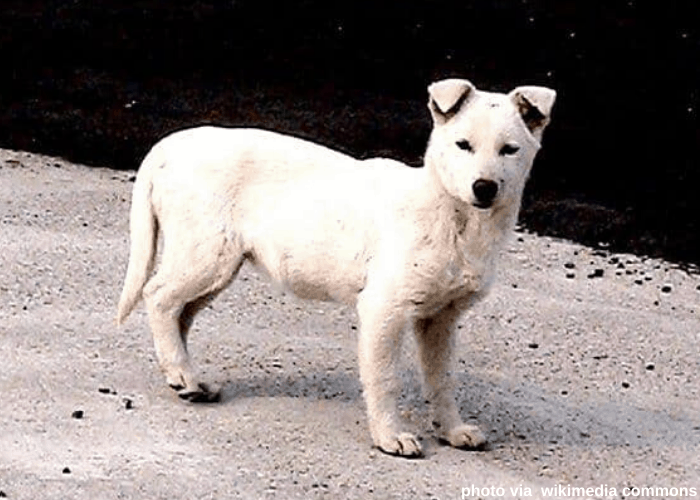 Description:
Description:
The Korean Jeju dog is rectangular in dimension, longer in length than in height.
They average about 20 inches in height and weigh anywhere between 40 to 60 pounds.
They range in color from white to tawny to brown and are often said to resemble different animals.
The female Jejus are often compared to foxes, while the males look like wolves.
The Jeju’s look a lot like the Korean Jindo but have tails that come to an abrupt point.
They are also set apart from the Jindu with their wide and pointed foreheads.
Temperament and Personality:
Like some other dogs on the Korean dog breeds list, the Jeju is considered an excellent guard dog.
While they are sensitive and intelligent animals, they are also very aggressive when hunting.
Their loyalty to their family makes them good at setting off an alarm when intruders are near.
Jejus were often used for hunting and military applications throughout history, which made them very territorial and aggressive towards other animals.
Because of this, Jeju’s can be difficult to socialize with other dogs and animals and are best in homes where they are the lone ranger.
They are considered good with older children but should constantly be monitored when younger children are present.
History:
The Jeju dog was originally bred on Jeju Island off the southern coast of Korea, where they obtained the Jeju name.
As far as popular dog breeds in Korea go, the Jeju is considered quite old and is thought to date over 5000 years ago.
They were originally introduced by the Chinese so many centuries ago but were almost driven to extinction by the Japanese between 1910 and 1931.
During this time, Japanese authorities ordered slaughtering all dogs indigenous to Korea.
Many breeds went extinct, and though the Jeju breed did manage to survive, their numbers were minimal.
Since then, the numbers have slowly rebuilt, but as of 2010, there were still only 69 Jeju dogs in Korea.
They were designated as a National heritage animal to protect what is left of the breed.
Did You Know?
- The Japanese were not the only reason the Jeju faced extinction. For many years, the Jeju was one of the most consumed dogs in Korea and the Nureongi.
- In the 1980s, only three Jeju dogs remained on the island, and it was through these three the breed was revived.
7) Pungsan Dog
 Description:
Description:
While many famous dog breeds in Korea originated in South Korea, the Pungsan dog originated in North Korea.
They are considered medium to large in build, with a thick, white fur coat.
The coat is always white, though it may have a tinge of cream. The breed can range from 55cm to 60cm tall and weighs between 20-30 kg.
Their strong and muscular bodies make them extremely agile, and, like the Jindo, their straight-standing ears help them stay alert at all times.
Personality and Temperament:
Like many Korean dog breeds, the Pungsan is very loving and loyal.
They are more independent than your average dog, but their independence does mean they have a greater tendency toward aggression, especially towards other animals.
These muscular dogs are extremely powerful, so their interactions should always be supervised even though they are very loving and affectionate with children.
The Pungsan is considered a very territorial dog but intelligent enough to know when to bark versus display aggression.
In return, they make excellent guard dogs. Pungsans are extremely intelligent, though very stubborn – training can be difficult.
History:
Like many Korean dog breeds, the exact origin of the Pungsan is unknown.
Most people, however, believe that the dog was bred during the Joseon Dynasty as a means to hunt big game.
Some others theorize that the Pungsan resulted from dogs mating with wolves, which would explain their aggressive nature and strong ability to hunt.
Unfortunately, the breed has not always thrived in Korea, and during the Japanese occupation, they were often killed for their thick fur coats.
Only through the North Korean government’s effort was the breed re-established, but the breed was limited to North Korea.
Today they are seen in South Korea but are not particularly popular outside of the country.
Did You Know?
- In 2000, North and South Korean leaders agreed and exchanged Pungsan puppies as a peace offering.
- Legend has it that in a battle between a Pungsan and a Siberian Tiger, the Pungsan won.
- In the 1900s, Pungsans were often smuggled into South Korea.
Conclusion:
And there you have it – these are Korea’s top 7 popular dog breeds.
Sadly, many of these breeds are still facing extinction. Today, breeds like the Nureongi are continuously raised in slaughterhouses for their meat.
While animal rights activists are continuously fighting for the rights of dogs in Korea, we must educate ourselves and take action.
You don’t have to travel to Korea to stop the trade – donate, sign a petition – every action helps.
If dogs taste like pork, will you eat them?
Check Out More Dogs Of Asian Origin Below:
- 21 Native Chinese Dogs
- Philippine Native Dogs
- Japanese Native Dog Breeds
- Native Tibetan Dog Breeds
- Dogs From Russia
- Turkish Dogs


